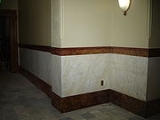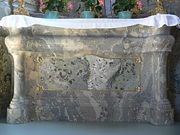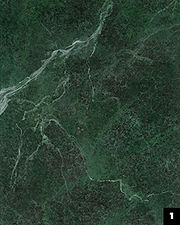
Faux marbling
Encyclopedia
Marbleizing or faux marbling is the preparation and finishing of a surface to imitate the appearance of polished marble
. It is typically used in buildings where the cost or weight of genuine marble would be prohibitive. Faux marbling is a special case of faux painting used to create the distinctive and varied patterns of marble - the most imitated stone by far.


with two schools of faux painting developing. The Italian school was loose and artistic, the French school was formal and realistic. It typically took an apprentice ten years or more to fully master the art. The sophistication of the techniques are such that visitors are frequently unable to distinguish between false and real marble in many churches, palaces and public buildings in Europe. The techniques were perfected by the 17th century and have been used in all styles of construction well into the 20th century, including Baroque
, palladian, neoclassical
and historical revival styles as well as Art Nouveau
and Art Deco
buildings. Craftsmen who are able to replicate this work are still available, as evidenced, for example, by the extensive restorations of faux marble surfaces in important Eastern Europe buildings since 1990.
The art of marbling and graining reached its apogee in Britain between 1845 and 1870, and during this period the acknowledged master was Thomas Kershaw.
Kershaw was born in Standish, Lancashire England in April in 1819. At the age of twelve he was apprenticed to Mr. John Platt of Bolton who was paid the sum of Twenty Three Pounds by Kershaw’s father in order that his son could be instructed in the craft of house painting. He worked ten hours a day and six days a week. He completed his apprenticeship at the age of twenty one.
He achieved international fame, winning a number of the most prestigious awards at the major exhibitions of the age; The Great Exhibition, London, 1851 - a first prize medal; Exposition Universelle, Paris, 1855 - a first class medal; London Exhibition, 1862 - first prize.
His work was so good that it was often considered to be indiscernible from the original. He undertook work in many large, houses, mansions and stately homes throughout England and Wales and once declined an offer from the Russian Ambassador to imitate marbles on the interior of the Imperial Palace in St Petersburg. In 1858 he produced one of his important works in the Emperor’s Room in Buckingham Palace where all the pillars were done in imitation marble.
In modern times, William Holgate (1931-2002) from Clitheroe, Lancashire, was possibly the finest grainer & marbler in the world since Thomas Kershaw held the title 150 years ago.{cn} His achievements include the prestigious award known as the 'Freedom of the City and Guilds of London' and he was very proud to be made 'A Freeman of the Worshipful Company of Painter Stainers of Trinity Lane, London,' on March 14, 1995. He was also given the 'Lifetime Achievement Award' at the 2001 Paris Salon. His apprentice and protégé, Andrew Johnstone continues his tradition.
 Other techniques for producing faux marble include Scagliola
Other techniques for producing faux marble include Scagliola
, a costly process which involves the use of specially pigmented plasters, and terrazzo
, for flooring, in which marble chips are imbedded in cement, then ground and polished to expose the marble aggregate.
Modern professional faux finishers are very skilled and will use a variety of techniques to reproduce the colors, veining and luster of real marble or other building materials. However, many decorators will merely suggest the appearance of marble rather than accurately imitate a particular stone.
Marble
Marble is a metamorphic rock composed of recrystallized carbonate minerals, most commonly calcite or dolomite.Geologists use the term "marble" to refer to metamorphosed limestone; however stonemasons use the term more broadly to encompass unmetamorphosed limestone.Marble is commonly used for...
. It is typically used in buildings where the cost or weight of genuine marble would be prohibitive. Faux marbling is a special case of faux painting used to create the distinctive and varied patterns of marble - the most imitated stone by far.


History
Faux stone painting was widely used in Pompeii, but it really took off in Europe during the RenaissanceRenaissance
The Renaissance was a cultural movement that spanned roughly the 14th to the 17th century, beginning in Italy in the Late Middle Ages and later spreading to the rest of Europe. The term is also used more loosely to refer to the historical era, but since the changes of the Renaissance were not...
with two schools of faux painting developing. The Italian school was loose and artistic, the French school was formal and realistic. It typically took an apprentice ten years or more to fully master the art. The sophistication of the techniques are such that visitors are frequently unable to distinguish between false and real marble in many churches, palaces and public buildings in Europe. The techniques were perfected by the 17th century and have been used in all styles of construction well into the 20th century, including Baroque
Baroque
The Baroque is a period and the style that used exaggerated motion and clear, easily interpreted detail to produce drama, tension, exuberance, and grandeur in sculpture, painting, literature, dance, and music...
, palladian, neoclassical
Neoclassical architecture
Neoclassical architecture was an architectural style produced by the neoclassical movement that began in the mid-18th century, manifested both in its details as a reaction against the Rococo style of naturalistic ornament, and in its architectural formulas as an outgrowth of some classicizing...
and historical revival styles as well as Art Nouveau
Art Nouveau
Art Nouveau is an international philosophy and style of art, architecture and applied art—especially the decorative arts—that were most popular during 1890–1910. The name "Art Nouveau" is French for "new art"...
and Art Deco
Art Deco
Art deco , or deco, is an eclectic artistic and design style that began in Paris in the 1920s and flourished internationally throughout the 1930s, into the World War II era. The style influenced all areas of design, including architecture and interior design, industrial design, fashion and...
buildings. Craftsmen who are able to replicate this work are still available, as evidenced, for example, by the extensive restorations of faux marble surfaces in important Eastern Europe buildings since 1990.
The art of marbling and graining reached its apogee in Britain between 1845 and 1870, and during this period the acknowledged master was Thomas Kershaw.
Kershaw was born in Standish, Lancashire England in April in 1819. At the age of twelve he was apprenticed to Mr. John Platt of Bolton who was paid the sum of Twenty Three Pounds by Kershaw’s father in order that his son could be instructed in the craft of house painting. He worked ten hours a day and six days a week. He completed his apprenticeship at the age of twenty one.
He achieved international fame, winning a number of the most prestigious awards at the major exhibitions of the age; The Great Exhibition, London, 1851 - a first prize medal; Exposition Universelle, Paris, 1855 - a first class medal; London Exhibition, 1862 - first prize.
His work was so good that it was often considered to be indiscernible from the original. He undertook work in many large, houses, mansions and stately homes throughout England and Wales and once declined an offer from the Russian Ambassador to imitate marbles on the interior of the Imperial Palace in St Petersburg. In 1858 he produced one of his important works in the Emperor’s Room in Buckingham Palace where all the pillars were done in imitation marble.
In modern times, William Holgate (1931-2002) from Clitheroe, Lancashire, was possibly the finest grainer & marbler in the world since Thomas Kershaw held the title 150 years ago.{cn} His achievements include the prestigious award known as the 'Freedom of the City and Guilds of London' and he was very proud to be made 'A Freeman of the Worshipful Company of Painter Stainers of Trinity Lane, London,' on March 14, 1995. He was also given the 'Lifetime Achievement Award' at the 2001 Paris Salon. His apprentice and protégé, Andrew Johnstone continues his tradition.

Scagliola
Scagliola , is a technique for producing stucco columns, sculptures, and other architectural elements that resemble inlays in marble and semi-precious stones...
, a costly process which involves the use of specially pigmented plasters, and terrazzo
Terrazzo
Terrazzo is a composite material poured in place or precast, which is used for floor and wall treatments. It consists of marble, quartz, granite, glass or other suitable chips, sprinkled or unsprinkled, and poured with a binder that is cementitious, chemical or a combination of both...
, for flooring, in which marble chips are imbedded in cement, then ground and polished to expose the marble aggregate.
Modern professional faux finishers are very skilled and will use a variety of techniques to reproduce the colors, veining and luster of real marble or other building materials. However, many decorators will merely suggest the appearance of marble rather than accurately imitate a particular stone.

